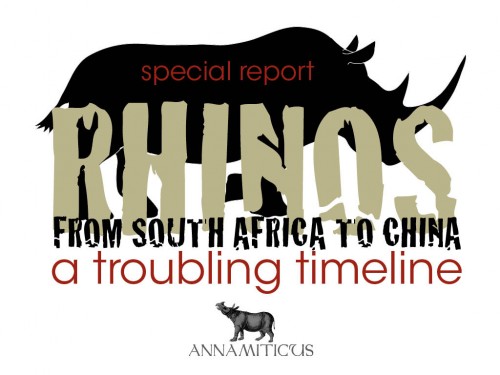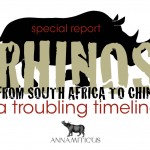
The peculiar case of the rhinos exported from South Africa to China continues to unravel with reports that some of the rhinos destined for Yunnan Wild Animal Park in Kunming did not survive the journey.
Marketing manager for Yunnan Wild Animal Park (YWAP), Li Li, admitted to NewsChina that out of 12 rhinos purchased from Kruger National Park and private game reserves, three of the rhinos were dead upon arrival in 2010. The deal was signed “after a long negotiation process” in 2009.
It has also been revealed that Kingland Group Co., Ltd — a company which “manufactures pipelines and promotes eco-tourism” — provided significant funds for bringing the rhinos to China. Kingland is reportedly financing the import of another 30 rhinos, although “further negotiations with South Africa and other African countries had recently stalled”. Besides YWAP, the Sanya City “center for artificial propagation of the rhinoceros” in Hainan Province imported significant numbers of white rhinos from South Africa and has been conducting “horn harvesting experiments” under the guise of “reintroducing wild rhinoceroses from overseas through establishment of breeding centers”. (YWAP denied any connection to the Hainan Province facility, according to NewsChina.)
Other companies linked to importing rhinos to China include the Mekong Group, Shin Lin Longhui Wildlife Research Co. Ltd / Longui Pharmaceutical Company, and the Hawk Group (an arms manufacturer, of which Longhui is a subsidiary). On the export side in South Africa, De Cai International, Jimmy Magill, and Thaba Manzi Nature Reserve have been identified.
Claims made by YWAP that the white rhinos are being “reintroduced to the wild” in Pu’er National Park have been debunked by experts, such as Zhang Li, Director of Programs of Conservation International (CI) in China and an associate professor at Beijing Normal University on Animal Behavior. Zhang explains that the white rhino is not native to China, “thus, from a conservation perspective, the project was neither a ‘re-introduction’ nor necessarily beneficial to the local ecosystem”.
Dr. Tom Milliken, rhino horn trade expert with the wildlife trade monitoring network TRAFFIC said the reintroduction scheme is “not conservation” and that the rainforest environment is completely unsuitable for white rhinos.
“These animals will just not survive in a rainforest-type environment. We have concerns about nutrition and their overall ability to cope. If they don’t have supplementary food, they could starve. This is simply not conservation.”
Xie Yan, China’s National Program Director of the Wildlife Conservation Society (WCS), is concerned about plans to breed rhinos for “medicinal use” in China.
“If the consumption of farmed rhino horn is legalized, social demand will surge and the market will stimulate poaching.”
South Africa has lobbied unsuccessfully for a legal trade in rhino horn for quite some time, with private rhino owners hoping to cash in on their rhino horn stockpiles and farm rhinos for horns. However, Dr. Ron Orenstein — author of Ivory, Horn and Blood: Behind the Elephant and Rhinoceros Poaching Crisis — points out that if China succeeds in generating its own rhino horn supply, the riches envisioned by South Africa’s rhino horn farmers will not materialize.
China is notorious for circumventing CITES for its own commercial purposes. For example, China has been touting its “tiger farms” as conservation, while it is well known that these operations are simply a conduit for China’s massive illegal trade in tiger parts. Likewise, commercial bear bile-extraction facilities were supposed to protect wild bears. Instead, both schemes have turned out to be disastrous for wild tigers and bears.
For the full backstory on China’s rhino horn scheme, download our special report Rhinos from South Africa to China: A Troubling Timeline, which we distributed in March 2013 at CITES CoP16 in Bangkok.




